Artificial Intelligence In IVD Market Size
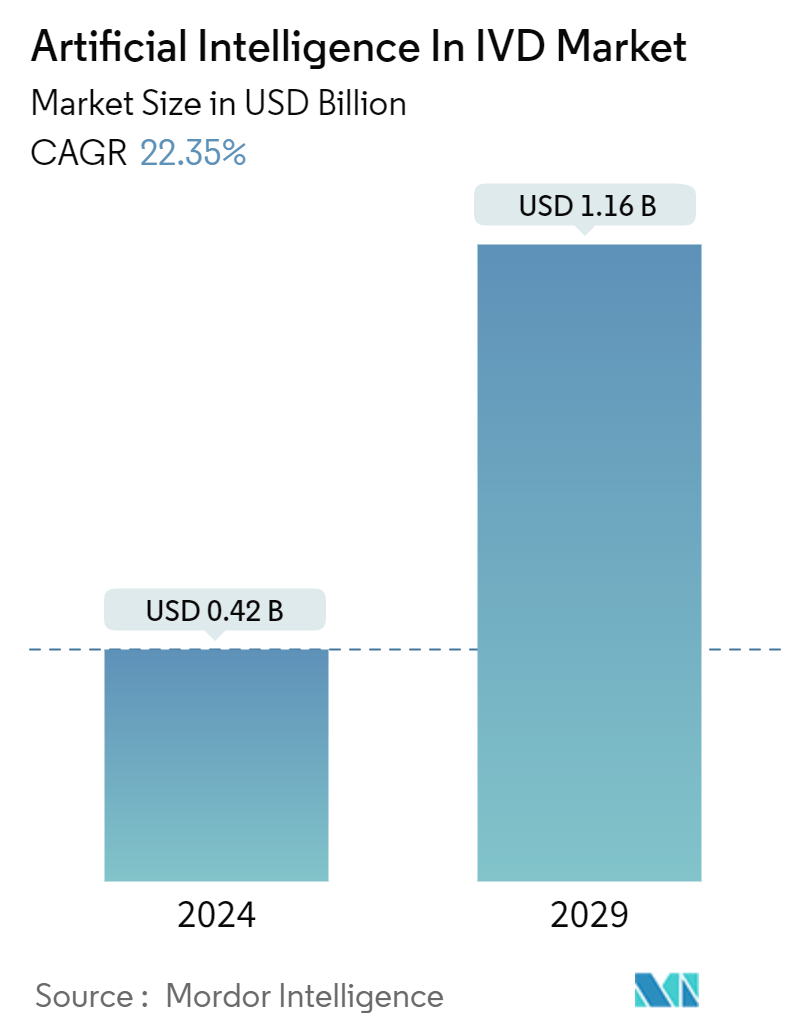
| Study Period | 2019 - 2029 |
| Market Size (2024) | USD 0.42 Billion |
| Market Size (2029) | USD 1.16 Billion |
| CAGR (2024 - 2029) | 22.35 % |
| Fastest Growing Market | Asia Pacific |
| Largest Market | North America |
Major Players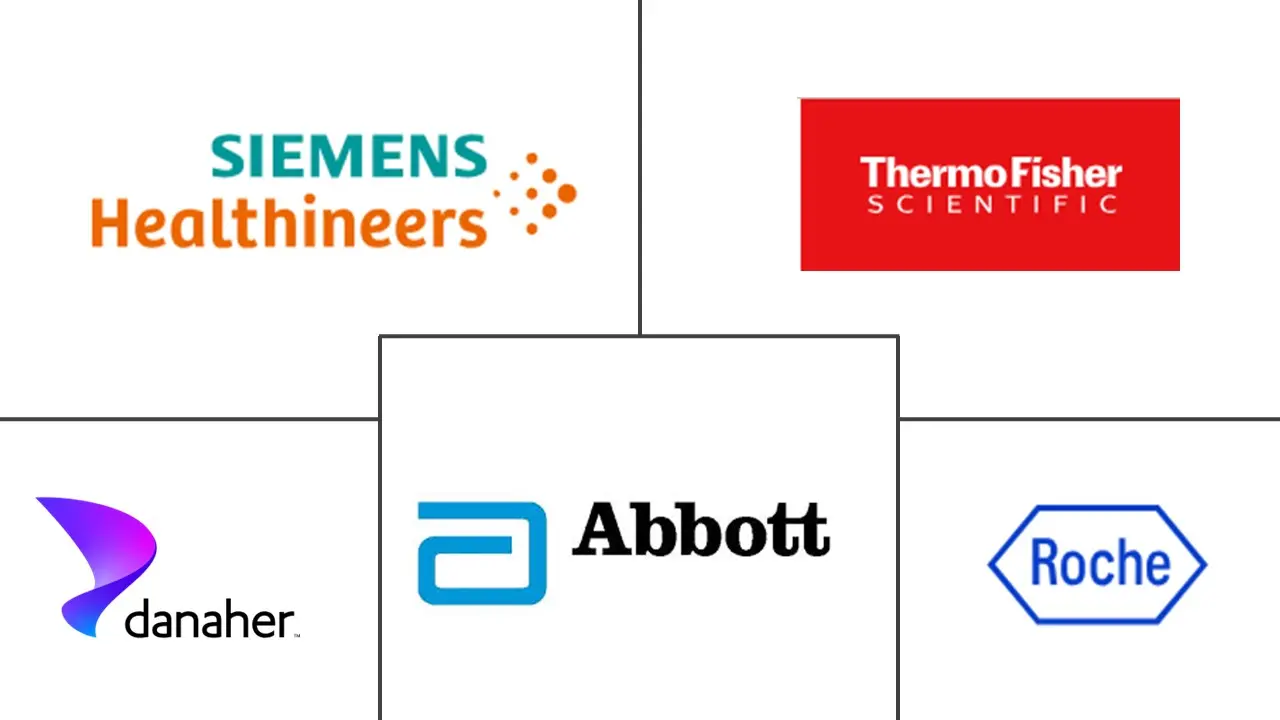
*Disclaimer: Major Players sorted in no particular order |
Artificial Intelligence In IVD Market Analysis
The Artificial Intelligence In IVD Market size is estimated at USD 0.42 billion in 2024, and is expected to reach USD 1.16 billion by 2029, growing at a CAGR of 22.35% during the forecast period (2024-2029).
The growing burden of chronic and infectious diseases, rising demand for early disease detection, and advancements in artificial intelligence (AI) technology are expected to boost the expansion of artificial intelligence in the IVD market.
The prevalence of chronic diseases such as diabetes, cardiovascular disorders, and cancer is increasing globally. AI technologies are being increasingly utilized to enhance diagnostic accuracy, efficiency, and personalized treatment options for these conditions. By analyzing large datasets and identifying patterns that human experts may miss, AI in IVD enables earlier disease detection, better risk assessment, and more effective management strategies. For instance, according to the British Heart Foundation, in January 2024, around 7.6 million people in the United Kingdom lived with heart and circulatory diseases in 2023.
As per the same source, around 4 million males and 3.6 million females in the United Kingdom lived with heart and circulatory diseases in 2023. Studies suggest that over half of the United Kingdom population will likely develop a heart or circulatory condition during their lifetime. Thus, the rising cases of cardiovascular disease are driving the market by enabling early detection through advanced data analysis, predicting disease progression, enhancing imaging analysis accuracy, and providing clinical decision support.
Also, AI offers advanced capabilities to analyze extensive patient data and detect disease indicators at early stages. For instance, an article published by Sensors in August 2022 stated that the AI-powered universal diagnostic system has undergone rigorous validation in extensive clinical studies, demonstrating its effectiveness in identifying early disease detection markers and assessing disease severity across various applications such as cardiovascular diseases, COVID-19, and oral cancer. Thus, AI's ability to analyze complex data from imaging enables accurate and timely disease detection, supports personalized medicine, and improves overall healthcare efficiency, which will be anticipated to drive the growth of the market during the forecast period.
Hence, due to the aforementioned factors, such as the growing cases of cardiovascular disease and the rising capabilities of AI for early disease detection, the market is expected to continue to grow in the coming years. However, stringent regulatory approval processes and data privacy and security concerns significantly hinder the adoption of AI during the forecast period.
Artificial Intelligence In IVD Market Trends
The Cardiology Segment is Expected to Hold a Significant Share in the Market During the Forecast Period.
Cardiovascular diseases (CVDs) such as heart disease, stroke, and hypertension are rising globally. As coronary artery disease (CAD) continues to pose a substantial global health burden, AI-driven advancements in diagnostic capabilities are helping to revolutionize early detection, risk assessment, and treatment planning. For instance, according to the Centers for Disease Control and Prevention in December 2023 reports that coronary artery disease affects approximately 20.5 million adults in the United States, establishing it as the most prevalent form of heart disease in the country in 2023. Therefore, these rising cases of CAD enhance diagnostic accuracy, streamline healthcare workflows, and ultimately improve patient outcomes through tailored, propelling the adoption of AI within the cardiology segment of the IVD market.
Additionally, AI analyzes complex data (images and medical history) to catch earlier CVDs like heart failure or arrhythmias and infectious diseases. This allows for faster, more personalized treatments and potentially prevents future heart attacks or strokes. For instance, as per the article published in the Cureus Journal in March 2024, AI methods accelerate the diagnosis and treatment of CVDs, including heart failure, atrial fibrillation, valvular heart disease, hypertrophic cardiomyopathy, and congenital heart disease.
Further, the article published in Springer Nature in November 2023 stated that the CE-mark approval from the Australian Therapeutic Goods Administration (TGA) establishes a significant regulatory approval of AI-based tools in infectious disease detection. Thus, the rising adoption of AI tools to identify cardiovascular and infectious diseases is anticipated to fuel the market's growth during the forecast period.
Hence, the growing cases of heart disease, such as coronary artery disease, and the rising adoption of AI methods in the diagnosis of CVDs are expected to continue to grow in the coming years.
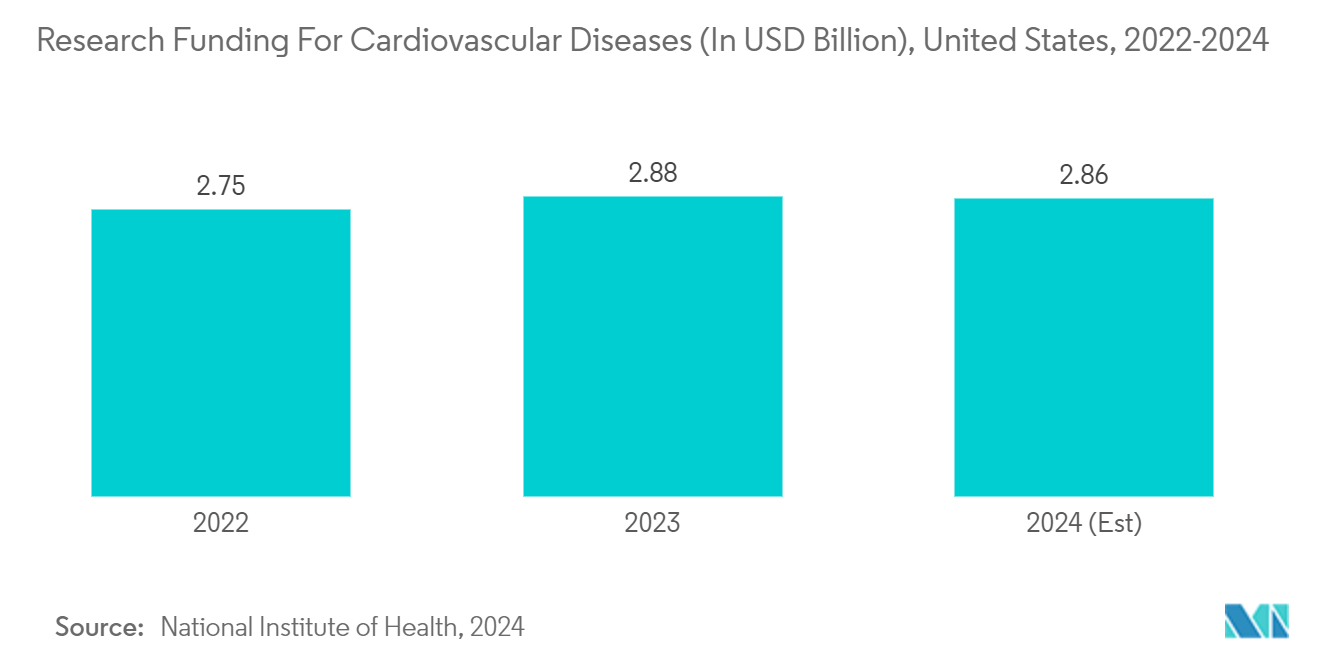
North America is Expected to Hold a Significant Market Share During the Forecast Period
North America is experiencing growth driven by the increasing demand for early disease detection, the government's focus on funding, and the rising advancement in technology in the region.
The rising cancer cases propelled the adoption of AI in the North American IVD market by enhancing early detection capabilities, supporting personalized medicine approaches, improving healthcare efficiency, and driving innovation. For instance, according to the American Cancer Society, in January 2024, the United States will experience over 2.0 million new cancer diagnoses in 2024. Additionally, according to the Canadian Cancer Society, in May 2024, researchers projected 247,100 new cancer cases in Canada, translating to an average of 675 daily diagnoses in 2024. Thus, AI enhances early detection through advanced data analysis, improves diagnostic efficiency, and fosters research innovation for cancer, further increasing market expansion during the forecast period.
Also, the government focuses on funding for machine learning and artificial intelligence in the United States. For instance, according to the National Institute of Health, in March 2023, the US government invested USD 2,142 million in machine learning and artificial intelligence in healthcare. Therefore, the government's rising fundamental investment is anticipated to fuel the growth of the market during the forecast period.
Additionally, platforms such as Google Cloud focus on advancement in the application of AI in the healthcare industry. For instance, in October 2022, Google Cloud launched a groundbreaking solution called Medical Imaging Suite, aiming to transform how healthcare professionals handle and utilize medical imaging data. This industry-changing suite promotes accessibility, interoperability, and improved patient care. Thus, the advancements in platforms like Google Cloud's Medical Imaging Suite highlight the transformative impact of AI in healthcare. AI-driven solutions in IVD are revolutionizing diagnostic processes by enhancing the accuracy, efficiency, and accessibility of diagnostic tests, ultimately improving patient care outcomes, which will boost the growth of the market during the forecast period.
Due to factors like the increasing number of cancer cases, government initiatives to raise funds for machine learning and artificial intelligence, and the growing use of Google Cloud's AI in the healthcare industry, the market is expected to experience significant growth in the region.
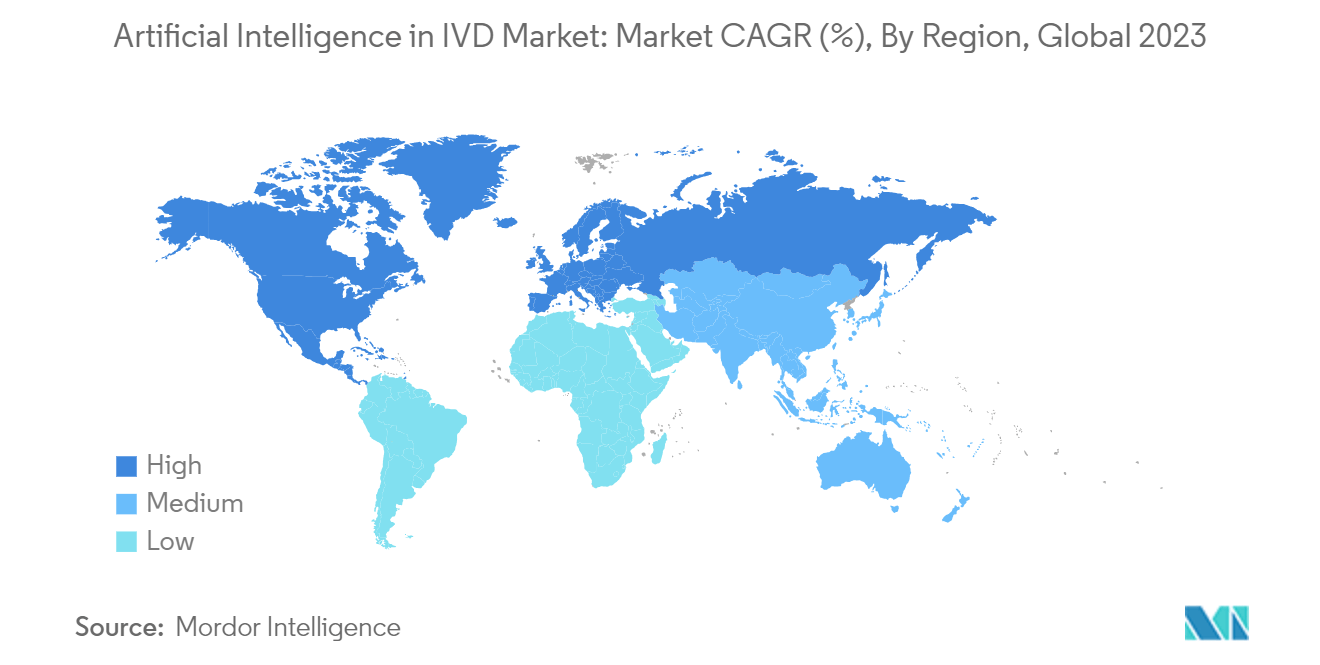
Artificial Intelligence In IVD Industry Overview
The artificial intelligence in the IVD market is moderately fragmented due to several companies operating globally and regionally. Major players in the market focus on regulatory approval in particular countries and product launches to expand their presence in the global market. The competitive landscape includes an analysis of a few international and local companies that hold market shares and are well known, including Abbott, F. Hoffmann-La Roche Ltd, Siemens Healthineers AG, Thermo Fisher Scientific Inc., Danaher Corporation (Beckman Coulter), Sysmex Corporation, and BioMérieux.
Artificial Intelligence In IVD Market Leaders
-
Abbott
-
F. Hoffmann-La Roche Ltd
-
Siemens Healthineers AG
-
Thermo Fisher Scientific, Inc.
-
Danaher Corporation (Beckman Coulter)
*Disclaimer: Major Players sorted in no particular order
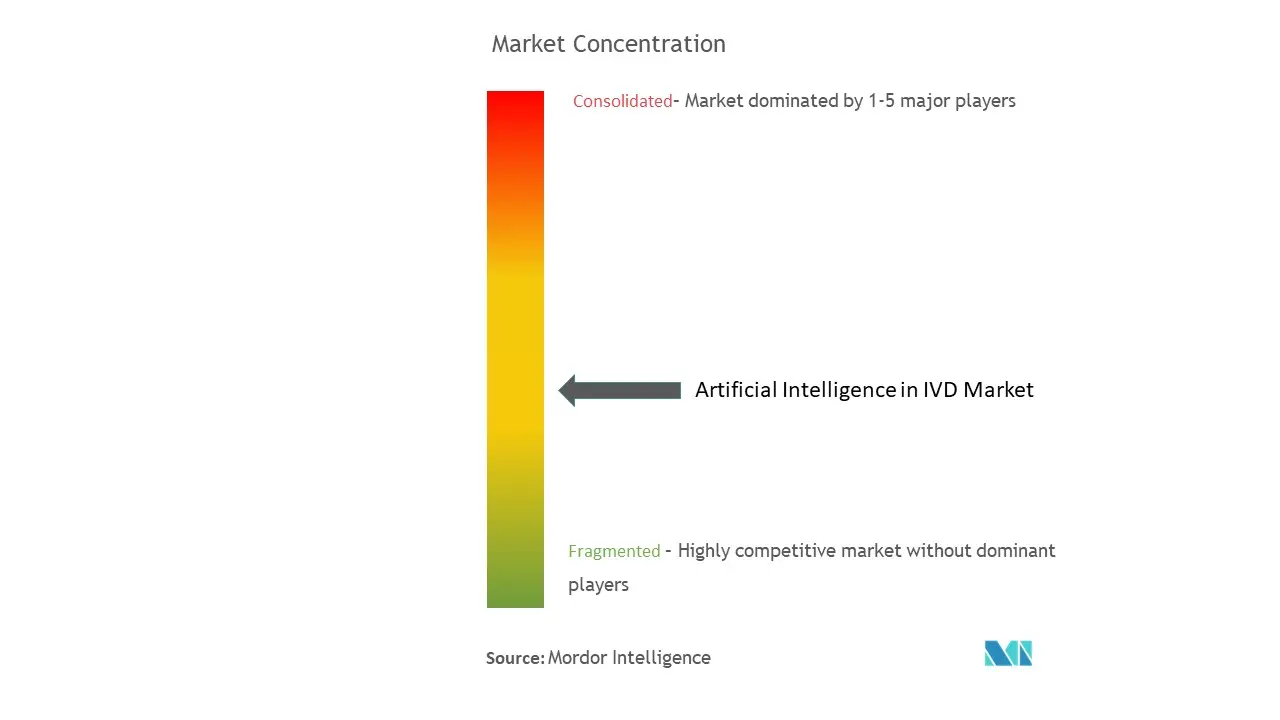
Artificial Intelligence In IVD Market News
- November 2023: Deep Bio, an AI healthcare company focusing on deep learning and cancer pathology, participated in the CancerX initiative, a public-private partnership unveiled as part of the White House Cancer Moonshot program. This strategic partnership achieves milestones to transform the landscape of cancer diagnosis and prognosis using AI expertise.
- November 2023: China-based companies XtalPi and CK Life Sciences signed a partnership agreement to develop miRNA-based postoperative molecular diagnostic models for prognostic risk prediction. The companies will leverage XtalPi's advanced artificial intelligence (AI) algorithms to analyze anonymized clinical and biomarker data from cancer patients and healthy individuals within CK’s repository.
Artificial Intelligence In IVD Market Report - Table of Contents
1. INTRODUCTION
- 1.1 Study Assumptions and Market Definition
- 1.2 Scope of the Study
2. RESEARCH METHODOLOGY
3. EXECUTIVE SUMMARY
4. MARKET DYNAMICS
- 4.1 Market Overview
-
4.2 Market Drivers
- 4.2.1 Growing Demand for Early Disease Detection
- 4.2.2 Advancements in AI Technology
- 4.2.3 Rising Burden of Chronic and Infectious Diseases
-
4.3 Market Restraints
- 4.3.1 Stringent Regulatory Approval Processes
- 4.3.2 Data Privacy and Security Concerns
-
4.4 Porter's Five Force Analysis
- 4.4.1 Threat of New Entrants
- 4.4.2 Bargaining Power of Buyers/Consumers
- 4.4.3 Bargaining Power of Suppliers
- 4.4.4 Threat of Substitute Products
- 4.4.5 Intensity of Competitive Rivalry
5. MARKET SEGMENTATION (Market Size by Value - USD)
-
5.1 By Application
- 5.1.1 Oncology
- 5.1.2 Infectious Disease
- 5.1.3 Cardiology
- 5.1.4 Other Applications
-
5.2 By Technology
- 5.2.1 Machine Learning
- 5.2.2 Deep Learning
- 5.2.3 Other Technologies
-
5.3 By End User
- 5.3.1 Hospitals and Clinics
- 5.3.2 Diagnostic Laboratories
- 5.3.3 Other End Users
-
5.4 Geography
- 5.4.1 North America
- 5.4.1.1 United States
- 5.4.1.2 Canada
- 5.4.1.3 Mexico
- 5.4.2 Europe
- 5.4.2.1 Germany
- 5.4.2.2 United Kingdom
- 5.4.2.3 France
- 5.4.2.4 Italy
- 5.4.2.5 Spain
- 5.4.2.6 Rest of Europe
- 5.4.3 Asia-Pacific
- 5.4.3.1 China
- 5.4.3.2 Japan
- 5.4.3.3 India
- 5.4.3.4 Australia
- 5.4.3.5 South Korea
- 5.4.3.6 Rest of Asia-Pacific
- 5.4.4 Rest of the World
6. COMPETITIVE LANDSCAPE
-
6.1 Company Profiles
- 6.1.1 Abbott
- 6.1.2 F. Hoffmann-La Roche Ltd
- 6.1.3 Siemens Healthineers AG
- 6.1.4 Thermo Fisher Scientific Inc.
- 6.1.5 Danaher Corporation (Beckman Coulter)
- 6.1.6 Sysmex Corporation
- 6.1.7 BioMerieux
- 6.1.8 Shenzhen Mindray Bio-Medical Electronics Co.
- 6.1.9 Cardinal Health
- 6.1.10 PerkinElmer
- *List Not Exhaustive
7. MARKET OPPORTUNITIES AND FUTURE TRENDS
** Subject To AvailablityArtificial Intelligence In IVD Industry Segmentation
As per the scope of the report, artificial intelligence (AI) in in-vitro diagnostics (IVD) refers to the use of computational algorithms and machine learning techniques to analyze diagnostic data, interpret results, and provide insights that enhance accuracy, efficiency, and clinical decision-making in laboratory testing and medical diagnostics. The AI in the IVD market is segmented by application, technology, end user, and geography. By application, the market is segmented into oncology, infectious disease, cardiology, and other applications. By technology, the market is segmented into machine learning, deep learning, and other technologies. By end user, the market is segmented into hospitals and clinics, diagnostic laboratories, and other end users. By geography, the market is segmented into North America, Europe, Asia-Pacific, and Rest of the World. The report offers the value (in USD) for the above segments.
| By Application | Oncology | |
| Infectious Disease | ||
| Cardiology | ||
| Other Applications | ||
| By Technology | Machine Learning | |
| Deep Learning | ||
| Other Technologies | ||
| By End User | Hospitals and Clinics | |
| Diagnostic Laboratories | ||
| Other End Users | ||
| Geography | North America | United States |
| Canada | ||
| Mexico | ||
| Geography | Europe | Germany |
| United Kingdom | ||
| France | ||
| Italy | ||
| Spain | ||
| Rest of Europe | ||
| Geography | Asia-Pacific | China |
| Japan | ||
| India | ||
| Australia | ||
| South Korea | ||
| Rest of Asia-Pacific | ||
| Geography | Rest of the World |
Artificial Intelligence In IVD Market Research FAQs
How big is the Artificial Intelligence In IVD Market?
The Artificial Intelligence In IVD Market size is expected to reach USD 0.42 billion in 2024 and grow at a CAGR of 22.35% to reach USD 1.16 billion by 2029.
What is the current Artificial Intelligence In IVD Market size?
In 2024, the Artificial Intelligence In IVD Market size is expected to reach USD 0.42 billion.
Who are the key players in Artificial Intelligence In IVD Market?
Abbott, F. Hoffmann-La Roche Ltd, Siemens Healthineers AG, Thermo Fisher Scientific, Inc. and Danaher Corporation (Beckman Coulter) are the major companies operating in the Artificial Intelligence In IVD Market.
Which is the fastest growing region in Artificial Intelligence In IVD Market?
Asia Pacific is estimated to grow at the highest CAGR over the forecast period (2024-2029).
Which region has the biggest share in Artificial Intelligence In IVD Market?
In 2024, the North America accounts for the largest market share in Artificial Intelligence In IVD Market.
What years does this Artificial Intelligence In IVD Market cover, and what was the market size in 2023?
In 2023, the Artificial Intelligence In IVD Market size was estimated at USD 0.33 billion. The report covers the Artificial Intelligence In IVD Market historical market size for years: 2019, 2020, 2021, 2022 and 2023. The report also forecasts the Artificial Intelligence In IVD Market size for years: 2024, 2025, 2026, 2027, 2028 and 2029.
Artificial Intelligence In IVD Industry Report
Statistics for the 2024 Artificial Intelligence In IVD market share, size and revenue growth rate, created by Mordor Intelligence™ Industry Reports. Artificial Intelligence In IVD analysis includes a market forecast outlook for 2024 to 2029 and historical overview. Get a sample of this industry analysis as a free report PDF download.



